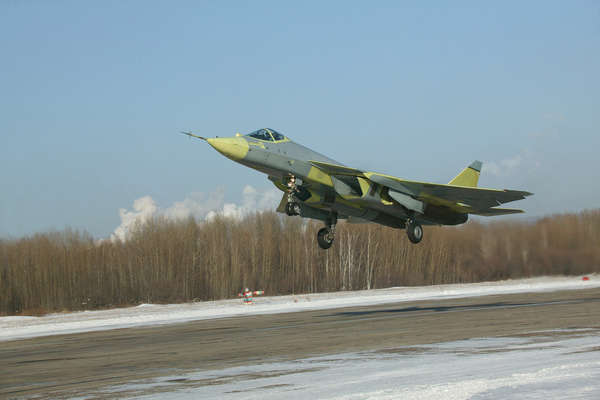Assessing the Sukhoi PAK-FA
Sukhoi/KnAAPO T-50/I-21/Article 701 PAK-FA
Перспективный Авиационный Комплекс Фронтовой Авиации
Air Power Australia Analysis 2010-01
15th February 2010
by Dr Carlo Kopp, SMAIAA, MIEEE, PEng,
Peter Goon, BE (Mech), FTE (USNTPS)
© 2010, Carlo Kopp, Peter Goon
Abstract
The public exposure of the Sukhoi/KnAAPO T-50/I-21/Article 701 PAK-FA or Перспективный Авиационный Комплекс Фронтовой Авиации following the 29th January, 2010, test flight has provided sufficient high resolution imagery, video camera footage, and incidental disclosures to perform an initial technical, techno-strategic, and strategic assessment of this new high performance low observable multirole fighter design.
The observed prototype design employs an interim supercruising and thrust vectoring engine, common to the production Su-35S Flanker. The configuration is intended to validate aerodynamic and systems performance, and is clearly not intended for full validation of low observables performance. A new 35 - 40 klbf class 3D TVC supercruising engine for the PAK-FA is currently being developed by NPO Saturn.
Analysis of PAK-FA prototype airframe shaping shows a design which has forward fuselage, inlet, upper fuselage, wing and tail surface airframe Very Low Observable (VLO/stealth) shaping which is highly competitive against the US F-22A Raptor and YF-23 ATF designs. Aft and centre lower fuselage, and aft fuselage and nozzle shaping is inferior to the F-22A Raptor and YF-23 ATF designs, sharing the same deficiencies as the F-35 Joint Strike Fighter. This may be an artefact of the use of the interim engines, and uncertainty about aft and beam sector observables performance will remain until later prototypes with the production engine and aft/lower fuselage shaping are available.
Analysis of PAK-FA prototype airframe aerodynamic features shows a design which is superior to all Western equivalents, providing ‘extreme agility’, superior to that of the Su-35S, through much of the flight envelope. This is accomplished by the combined use of 3D thrust vector control of the engine nozzles, all moving tail surfaces, and refined aerodynamic design with relaxed directional static stability and careful mass distribution to control inertial effects. The PAK-FA is fitted with unusually robust high sink rate undercarriage, intended for STOL operations.
Disclosures indicate that the avionic suite and systems fit will be derived from the Su-35S design, with the important difference in the use of an very high power-aperture product X-band multimode primary AESA radar. Five AESA apertures are intended for production PAK-FA aircraft. The highly integrated avionic suite is intended to provide similar data fusion and networking capabilities to the F-22A Raptor.
The available evidence demonstrates at this time that a mature production PAK-FA design has the potential to compete with the F-22A Raptor in VLO performance from key aspects, and will outperform the F-22A Raptor aerodynamically and kinematically. Therefore, from a technological strategy perspective, the PAK-FA renders all legacy US fighter aircraft, and the F-35 Lightning II Joint Strike Fighter, strategically irrelevant and non-viable after the PAK-FA achieves IOC in 2015.
Detailed strategic analysis indicates that the only viable strategic survival strategy now remaining for the United States is to terminate the Joint Strike Fighter program immediately, redirect freed funding to further develop the F-22 Raptor, and employ variants of the F-22 aircraft as the primary fighter aircraft for all United States and Allied TACAIR needs.
If the United States does not fundamentally change its planning for the future of tactical air power, the advantage held for decades will be soon lost and American air power will become an artefact of history.



